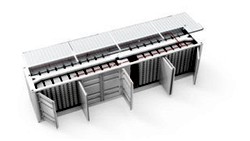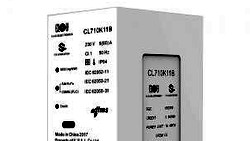The demand for electricity is constantly increasing, leading to a significant rise in nonlinear loads. Nonlinear circuits pose unique challenges in power systems due to their propensity to introduce harmonic distortion and flicker phenomena. Understanding the fundamental principles of nonlinear circuits, harmonic distortion, flicker phenomena, and the limitations of common instrument transformers is crucial for effective load modelling, analysis, and the implementation of appropriate mitigation strategies. This post will explore these topics and suggest possible solutions to address the challenges associated with nonlinear loads.
Nonlinear Circuits
Nonlinear circuits are characterized by non-ohmic elements that do not adhere to Ohm's Law, such as diodes, transistors, and nonlinear loads like computers, variable speed drives, and power electronics. Unlike linear circuits, where the current is directly proportional to the applied voltage, nonlinear circuits exhibit complex behaviours due to nonlinear current-voltage relationships. As a result, harmonics are introduced into the power system, leading to harmonic distortion.
Harmonic Distortion
Harmonic distortion refers to the presence of unwanted frequencies or harmonics in an electrical system that are multiples of the fundamental frequency. These harmonics can adversely affect power quality, leading to various issues such as increased losses, overheating of equipment, interference with communication systems, and reduced system efficiency. Harmonic distortion is quantified using Total Harmonic Distortion (THD), which measures the ratio of the root-mean-square (RMS) of the harmonic content to the RMS value of the fundamental frequency.
In addition to harmonics, there are two other categories of unwanted frequencies that can occur in electrical systems: sub-harmonics and inter-harmonics.
Sub-harmonics are frequencies that are integer divisions of the fundamental frequency rather than multiples. For example, if the fundamental frequency is 50 Hz, a sub-harmonic could be 25 Hz (half the fundamental frequency) or 16.66 Hz (one-third of the fundamental frequency). Sub-harmonics can arise due to nonlinearities in the system or improper frequency synchronization, and can introduce distortion and instability.
Inter-harmonics, on the other hand, are frequencies that are not directly related to the fundamental frequency or its harmonics. They are often caused by non-linearities and disturbances within the electrical system. Inter-harmonics can appear at any frequency and are not restricted to integer multiples or divisions. These unwanted frequencies can interfere with the desired signals and cause distortion, noise, and other undesirable effects.
Flicker Phenomena
Flicker phenomena, also known as voltage flicker, is another significant consequence of nonlinear loads. It manifests as rapid, random voltage fluctuations that can cause visual annoyance, mal-operation of sensitive equipment, and even health issues in extreme cases. Flicker is primarily caused by load variations and rapid changes in load impedance, leading to voltage fluctuations that propagate throughout the power system. It is quantified using indicators such as short-term flicker severity (Pst) and long-term flicker severity (Plt).

(symbol image, credit CLOU)
Possible Impacts on Instrument Transformers
From the metering perspective, the accuracy of data acquisition is greatly influenced by current transformers (CTs) and potential transformers (PTs). These instrument transformers are essential for ensuring precise measurements and reliable data for various applications. Understanding the impact and limitations of CTs and PTs is essential for maintaining accurate metering and facilitating efficient energy management. Instrument transformers are not immune to the challenges posed by nonlinear loads.
Common shortcomings include:
- Saturation
Instrument transformers have a limited dynamic range, and when subjected to high levels of harmonic currents or voltages, they can saturate. Saturation alters the waveform shape, leading to inaccurate measurements and distorted relay signals. - Frequency Response
Instrument transformers are designed to accurately measure the fundamental frequency components. However, their performance degrades as the frequency increases, especially in the presence of harmonics. This limitation can lead to inaccurate readings and compromised system protection. - Phase Shift
Nonlinear loads can introduce phase shifts between voltage and current waveforms. Instrument transformers, which assume ideal power factor conditions, may not capture this phase shift accurately, affecting measurements and protection schemes.
Load Modelling and Analysis
Load modelling plays an important role in analysing non-linear loads in electrical systems. Non-linear loads are those that do not exhibit a linear relationship between voltage and current, typically due to the presence of electronic devices such as computers, power electronics, and variable speed drives. These loads draw current in a non-sinusoidal manner, leading to various issues such as harmonic distortion, voltage fluctuations, and power quality problems.
To accurately analyse the impact of non-linear loads on an electrical system, load modelling involves representing the behaviour of these loads mathematically. This allows system engineers to predict and evaluate the effects of non-linear loads on system performance and devise appropriate mitigation strategies.
Here are a few key aspects of load modelling when analysing non-linear loads:
- Non-linear Characteristics
Load modelling requires capturing the non-linear characteristics of the load. This involves understanding the voltage-current relationship of the load and expressing it through mathematical equations or models. Common load models used for non-linear loads include the current source model, harmonic current injection model, and time-domain simulation models. - Harmonic Content
Non-linear loads introduce harmonics into the electrical system, which can cause voltage distortion and affect the performance of other connected equipment. Load modelling involves determining the harmonic content of the load, including the magnitude and phase angle of each harmonic component. This information helps in assessing the severity of harmonic distortion and its potential impact on the system. - Frequency Response
Load modelling also considers the frequency response of non-linear loads. Non-linear loads can exhibit frequency-dependent behaviour, affecting their impedance characteristics and interaction with the power system. Understanding the frequency response allows for a more accurate representation of load behaviour during transient and steady-state conditions. - Dynamic Behaviour
Non-linear loads may exhibit dynamic behaviour due to factors such as switching events, load variations, and control mechanisms. Load modelling should account for these dynamic aspects to accurately simulate load responses and their impact on system stability, voltage regulation, and transient behaviour. - Load Aggregation
In larger power systems, load modelling involves aggregating individual non-linear loads into a comprehensive representation. This is necessary to assess the cumulative effects of multiple non-linear loads on system performance, identify potential hotspots, and determine appropriate system-level mitigation measures.
Load modeling of non-linear loads is typically performed using simulation software tools capable of analyzing power system behavior. These tools enable engineers to simulate various scenarios, evaluate the impact of non-linear loads on voltage profiles, harmonics, and power quality, and assess the effectiveness of different mitigation techniques.
Mitigation Strategies
To mitigate the adverse effects of nonlinear loads, several strategies can be employed:
- Harmonic Filters
Installing harmonic filters in the power system can effectively mitigate harmonic distortion caused by nonlinear loads. These filters consist of passive components, such as capacitors, inductors, and resistors, designed to attenuate specific harmonic frequencies. By selectively filtering out harmonics, the power system can operate closer to its ideal sinusoidal waveform, reducing the impact of harmonic distortion on equipment and improving overall power quality.
- Active Power Filters
Active power filters (APFs) are advanced devices that actively monitor the harmonic currents or voltages and generate compensating currents or voltages to cancel out the harmonics. APFs utilize power electronics and control algorithms to dynamically respond to changing load conditions and mitigate harmonic distortion. They are particularly effective in environments with high levels of nonlinear loads and can provide precise harmonic compensation across a wide range of frequencies.
- Voltage Regulation
Maintaining stable voltage levels is essential to mitigate flicker phenomena caused by nonlinear loads. Voltage regulators can be employed to dynamically control and regulate the voltage within acceptable limits. Automatic Voltage Regulators (AVRs) and Static Var Compensators (SVCs) are commonly used devices that actively adjust the system voltage to compensate for load variations, thereby minimizing flicker.
- System Design and Layout
Proper system design and layout can also contribute to mitigating the impact of nonlinear loads. Segregating sensitive loads from nonlinear loads and providing dedicated circuits or separate power sources can help minimize the propagation of harmonic distortion and flicker. Additionally, careful consideration of cable sizing, grounding techniques, and equipment placement can reduce the overall impact of nonlinear loads on the system.
- Energy-Efficient Equipment
Choosing energy-efficient equipment that complies with stringent power quality standards can significantly reduce the introduction of harmonics and flicker. Energy-efficient devices are designed to minimize power losses and operate at higher power factors, thereby reducing the impact of nonlinear loads on the system.
- Active Load Management
Implementing active load management strategies, such as demand response programs and load shedding techniques, can help regulate and balance the power demand. By dynamically adjusting the load profile, the system can minimize the operation of nonlinear loads during critical periods, reducing the overall impact on power quality.
- Continuous Monitoring and Analysis
Regular monitoring and analysis of power quality parameters, such as harmonic distortion, flicker, and voltage levels, are crucial for identifying and addressing issues related to nonlinear loads. Advanced monitoring systems equipped with real-time data acquisition and analysis capabilities can provide valuable insights into load behaviour, enabling proactive measures to be taken to mitigate potential problems.
Staying Up to Date
It is important for engineers and professionals in the field to stay updated with the latest advancements in load modelling and analysis techniques, as well as emerging mitigation strategies. Ongoing research and development efforts are focused on improving the accuracy of load models, enhancing instrument transformer performance in the presence of harmonics, and developing innovative solutions for efficient load management and power quality enhancement.
Furthermore, regulatory bodies and standards organizations play a vital role in setting guidelines and requirements for power quality, harmonics, and flicker mitigation. Compliance with these standards ensures that power systems operate within acceptable limits, minimizing the impact of nonlinear loads on both the grid and end-users.
Takeaway
Nonlinear load modelling, analysis, and mitigation strategies are important for keeping power systems safe and efficient in the presence of more nonlinear loads. By understanding the fundamental principles of nonlinear circuits, harmonic distortion, flicker phenomena, and the limitations of instrument transformers, professionals will be able to employ appropriate modelling techniques and implement effective mitigation strategies.
Through the integration of harmonic filters, active power filters, voltage regulation techniques, system design considerations, energy-efficient equipment, active load management, and continuous monitoring and analysis, power systems can mitigate the adverse effects of nonlinear loads, ensuring optimal power quality and reliable operation of electrical infrastructure.
Contact us at CLOU to unlock the power of our advanced metering and measurement equipment, empowering you to enhance grid stability and optimize power system performance. Discover innovative solutions tailored to your needs and pave the way for a more reliable and efficient energy future.
Editor's note: This article was originally published in August 2023 and has been updated for comprehensiveness.





All comments are moderated before being published. Inappropriate or off-topic comments may not be approved.